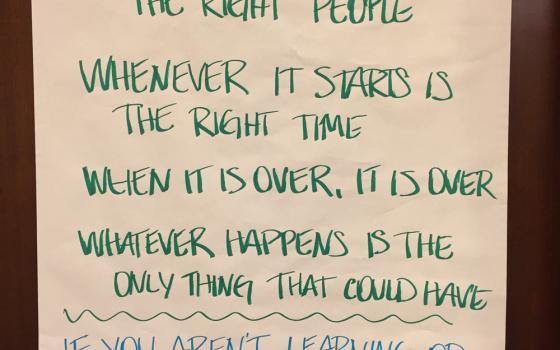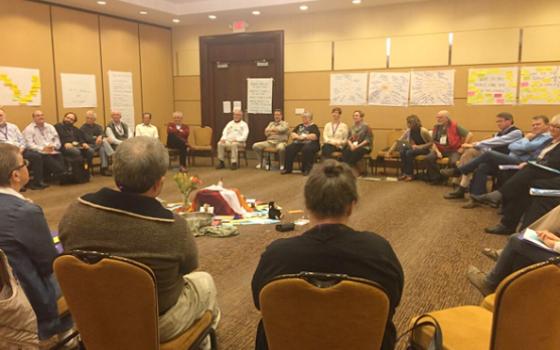It was a remarkable collection of forty individuals, most of whom had labored for decades in church reform under two papacies that looked upon reform as anathema. Many carried bruises and battle scars quietly in their hearts. They met in Chicago last October, an international network of priest associations and reform groups. The priests' groups hailed from Germany, Austria, Ireland, Slovakia, Switzerland, Australia, and the U.S. The reform organizations also came from these countries, as well as Italy, Argentina, and the United Kingdom.
Most of them I knew, or had met at a previous gathering in Limerick, Ireland. I was eager to see if some of the wounds felt by the group in Ireland around women's issues in the church had healed. Would there be any movement in the group's willingness to accept women in more visible liturgical roles? Or would the same fears and concerns resurface?
Redemptorist Fr. Tony Flannery, a founder of the Association of Catholic Priests, and Kate McElwee, co-executive director of the Women's Ordination Conference, suggested that the group celebrate the Eucharist without any main presiders. The group would sit in a circle, around an altar table, with different people praying various sections of the liturgy, but with the whole assembly reciting the Eucharistic prayer. This, they felt, would be a sign that gender is no barrier among us. Furthermore, the action could be interpreted according to the opinion of each participant.
And the opinions expressed were thoughtful and wide-ranging. A few who had disagreed with the suggestion made in Limerick that a male priest and a woman preside at the Eucharist, felt this latest suggestion for the manner of praying was "OK." One priest said this was an opportunity to practice the inclusivity we preach. Another disclosed, "When I celebrate Eucharist with students, I invite a woman to co-preside. I view this proposal as a compromise."
"Good," I thought. "The group is understanding this prayer in various ways. It seems comfortable with this ritual because, as some said, we should not call this a 'Mass' or 'Eucharist,' but 'breaking bread together.' " But my optimism was premature.
Whatever it was called, some priests, who were trying to dialogue with bishops, felt that participation in this kind of prayer would jeopardize their chances for such dialogue. Would this action advance the cause of women's priestly ordination or set it back if it became public? Another priest, who felt conflicted about the proposal added, "When I need to be prophetic, I want to know if it will produce fruit."
Helmut Schuller, a prophetic priest who engaged in a fair share of dialogue with bishops in the founding of the Austrian Priests' Initiative, offered what I thought was a gem of wisdom from his experience: "What reward do we get from obedience to the bishop?" He obviously had wrestled with laws and rules and when they should be followed.
When a rule or law is not in line with one's inner truth, does one follow the rule or one's inner truth? One priest, who had experienced Communist rule in his country, indicated that the answers are not clear-cut. He found that it is not always possible to say the truth, even though being open and public is the ideal. As he navigated the law, he kept in mind St. Paul's admonition that love trumps the law. "For the whole law can be summed up in this one command: Love your neighbor as yourself" (Galatians 5:14).
Then a flood of anguished feelings came from some of the women who felt the "clerical culture" was responsible for the power of some over the equality of all. Deborah Rose-Milavec, executive director of FutureChurch, pleaded, "I hope we don't decide on the backs of women again; this is so painful because it makes me feel that I am not part of the Body of Christ."
Another woman said that her community prays this way every week and she felt sad that a ritual meant to show unity was effectively divisive. Gloria Ulterino, a representative of RAPPORT (Renewing a Priestly People, Ordination Reconsidered Today), felt "very discouraged" as she never "anticipated such disagreement in this gathering." Gloria, together with Deb, Kate, Marianne Duddy-Burke, executive director of DignityUSA, and Marilyn Hatton, a representative of Women's Ordination Worldwide from Australia, drew up a letter, asking their brothers at the conference to "risk stepping out and acting courageously for women's full equality in the Church."
As in Limerick, I was disappointed that the proposed Chicago solution did not satisfy the group as a whole, even though all expressed genuine gratitude for the discussion. At the end of the conference, most prayed in the manner proposed, while about 10 people respectfully stayed apart and prayed their own prayer.
I filed these responses to women's liturgical role into my storehouse of learning. Did it have any implications for my particular ministry for lesbian, gay, bisexual, and transgender people? The group had easily adopted a resolution "to stand against violence in all its forms — physical, emotional, spiritual and temporal — toward LGBT people" and to "encourage the Church's leaders and individual members to make the same commitment." There were some minimal questions about this resolution but not the angst felt in discussing women's liturgical participation.
Was equality for women a thornier issue than equality for LGBT people? No, not really. The LGBT resolution was expressed in general terms of equality, without specific actions. The group had also called for, and agreed upon, progress on full equality for women in the church; but the proposal about women, like the one about LGBT people, was broad and did not include particular examples of equality.
So people of good will can agree on general principles, but it is in specific applications that the rubber meets the road. At the next international conference of priests and reform organizations in 2018, when we discuss concrete actions that affirm the dignity and rights of LGBT people, I need to be prepared for similar resistance, hesitations, and concerns when these human rights and civil liberties are spelled out.
I am convinced that, as a church, we agree on the big picture. Each one of us may have specific ideas about the details in the painting: the colors to be used, the shape of objects, or the size of the canvas, but on the whole work of art we see eye-to-eye. As members of the church, we are united in our faith and belief in Christ and in our desire to follow the greatest commandment: to love God and our neighbor as ourselves.
I need to be patient because movement on issues requires time. Just as some who had opposed the proposition in Limerick had moved in their thinking about women's liturgical role a year and a half later, there will be more movements in the future. I am pondering the words of Ecclesiastes 3:11: "God has made everything appropriate to its time."
[Jeannine Gramick is a Sister of Loretto who has been involved in a pastoral ministry for lesbian and gay Catholics since 1971. She co-founded New Ways Ministry and has been an executive coordinator of the National Coalition of American Nuns since 2003.]


